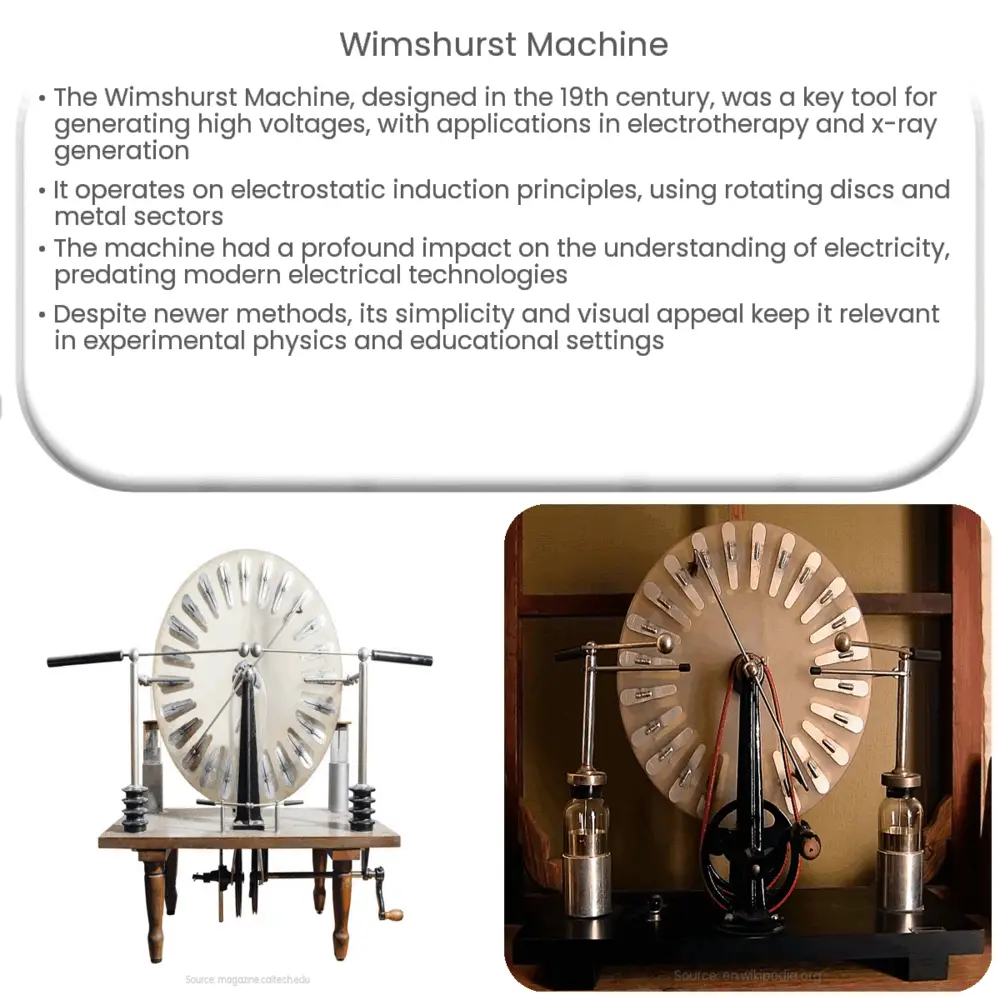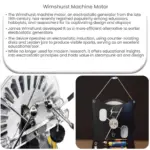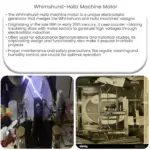Explore the fascinating world of the Wimshurst Machine, its design, scientific importance, modern applications, and how to build your own.

Introduction to the Wimshurst Machine
The Wimshurst Machine is an electrostatic generator, a fascinating device that captures the attention of many science enthusiasts. Designed by James Wimshurst in the late 19th century, this machine was primarily used for generating high voltages. Wimshurst’s creation saw widespread usage in electrotherapy and x-ray generation, highlighting its critical place in the field of scientific experimentation.
Design and Operation
The Wimshurst machine operates based on principles of electrostatic induction and influence. Two large discs, typically made of glass or clear plastic, are mounted side by side. These discs rotate in opposite directions with the help of a hand crank or motor. Adhered to each disc are a series of metal sectors, which play a critical role in the electrostatic induction process.
- First Step: The discs are set into motion, causing the metal sectors to move. A pair of neutralizer brushes contact the sectors, inducing charges via influence.
- Second Step: The induced charges are collected by a pair of collection brushes, which are connected to the Leyden jars (storage capacitors).
- Third Step: The Leyden jars store the electrical energy until discharged. The discharge is often through a pair of spark gaps creating a visible and audibly striking spark.
The amount of electricity generated, and the spark’s size, largely depends on factors like the size of the discs, the number of sectors, the efficiency of the conductive materials, and the speed at which the discs are turned.
Scientific Importance
The Wimshurst machine is more than just a visually stimulating scientific demonstration. It played a significant role in furthering our understanding of electricity. It was a predecessor to the modern technologies we use today, offering a tangible way to generate and study high voltage electrical charges.
The machine also holds an important educational value. Students use it to explore key scientific concepts in electricity and electrostatics, including charge, voltage, electric potential, and grounding.
Despite the advent of more advanced and efficient methods of generating electricity, the Wimshurst machine continues to be a significant tool in experimental physics due to its simplicity and the visual appeal of its operation.
Modern Applications and Variations
Although primarily used as an educational tool today, the Wimshurst machine also has a place in the world of modern science and entertainment. It is commonly found in science museums and school laboratories, demonstrating the principles of electrostatics in a tangible, visually engaging manner. Additionally, it serves as an impressive spectacle during science magic shows, capturing the imagination of the audience with its dramatic sparks.
Besides its traditional form, there are also numerous modern variations of the Wimshurst machine. For instance, the Bonetti machine, an interesting adaptation, incorporates additional neutralizer bars to improve its efficiency. Such modifications serve to further demonstrate the machine’s flexibility and its foundational place in the world of electrostatic generators.
Building Your Own Wimshurst Machine
If you’re interested in the hands-on experience of understanding electrostatic principles, building your own Wimshurst machine can be an exciting project. All you need are some basic materials like acrylic or glass discs, metal foil, a hand crank, and Leyden jars. Keep in mind, though, safety should be your utmost priority, given that this machine generates high voltages.
- Step 1: Construct the rotating discs with evenly spaced metal sectors.
- Step 2: Set up the neutralizing bars and collection brushes.
- Step 3: Attach the Leyden jars for storing the charges.
- Step 4: Install a hand crank or motor to set the discs in motion.
Following these steps, you should be able to construct a functioning Wimshurst machine. Remember to handle the machine with care to prevent potential electrostatic discharges.
Conclusion
In conclusion, the Wimshurst machine is a historical marvel of scientific innovation. Not only did it pave the way for our understanding of electricity, but it continues to serve as a captivating educational tool, demonstrating fundamental electrostatic principles in a visually impressive manner. Whether you are a budding scientist, a seasoned researcher, or simply a curious observer, the Wimshurst machine offers a window into the electrifying world of physics and engineering.




